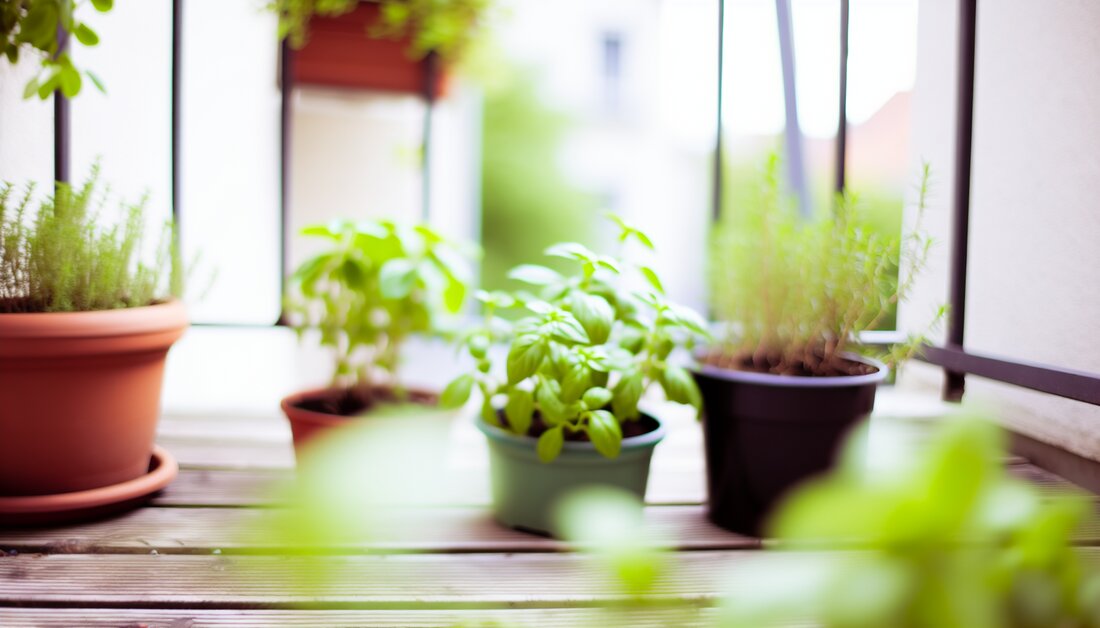Medicinal plants in pots – herb garden on the balcony and windowsill
Discover how you can grow and care for medicinal plants on your balcony and windowsill to improve health and interior design.

Medicinal plants in pots – herb garden on the balcony and windowsill
Imagine you have a small health garden right on your doorstep - on the balcony or windowsill. Medicinal plants in pots are not only a pretty eye-catcher, but also offer numerous health benefits. In this article, you'll learn how to use the best tips for growing and maintaining your own herb garden oasis.
Did you know that fresh herbs such as basil, thyme or peppermint not only spice up your dishes, but can also develop healing powers? Their use ranges from supporting the immune system to relieving minor aches and pains.
But that's not all. We'll show you how you can design your herb garden creatively and which locations are best suited to get the most out of your plants. Let's explore the secrets of this wonderful plant world - maybe you'll soon become the green thumb of your neighborhood!
Growing and caring for medicinal plants in pots on the balcony
Growing medicinal plants in pots on the balcony offers numerous advantages. Above all, flexible positioning and control over the growth conditions are essential. Popular medicinal plants include:basil,thyme,Parsleyandrosemary. These plants require adequate sunlight, ideally at least six hours per day.
The following points are crucial for care:
- Wasserversorgung: Heilpflanzen benötigen regelmäßige Bewässerung, aber Staunässe sollte vermieden werden. Drainagelöcher im Topf sind unerlässlich.
- Erde: Eine hochwertige, durchlässige Blumenerde ist optimal. Sie sollte zusätzlich mit Kompost angereichert werden, um Nährstoffe zu liefern.
- Düngung: Flüssigdünger alle vier bis sechs Wochen während der Wachstumsperiode unterstützt das gesunde Wachstum.
The ideal pot is at least 3-5 liters in size for optimal root development. Animal or plant fertilizers provide natural sources of nutrients. The soil pH should be between 6.0 and 7.0 to create optimal growing conditions.
Another important aspect is pest control. Watch out for mold, aphids or spider mites. Biological methods, such as neem oil or a simple soap solution, can be helpful.
A rotation of plants is recommended for cultivation in order to maintain soil fertility and prevent pests. Use different pots or arrangements to encourage a type of companion planting where plants positively influence each other.
Health benefits and uses of local herbs
Home herbs are not only aromatic ingredients in the kitchen, but also offer a number of health benefits. Many of these plants are rich in antioxidants, vitamins and minerals that can promote overall well-being. Example herbs are:
- Basilikum: Unterstützt die Verdauung und hat entzündungshemmende Eigenschaften.
- Petersilie: Reich an Vitamin K und C, fördert die Gesundheit von Knochen und Haut.
- Thymian: Kann bei Atemwegserkrankungen helfen und wirkt antibakteriell.
Additionally, many of these herbs can be used to relieve specific ailments. Studies have shown that:
- Minze: Effektiv gegen Kopfschmerzen und Übelkeit ist.
- Rosmarin: Die Konzentration und Gedächtnisleistung steigern kann.
- Kamille: Ein beruhigendes Mittel bei Schlafstörungen ist.
There are also different ways of preparing them that maximize the health benefits of the herbs. Tea, tinctures and essential oils are common methods of making optimal use of the active ingredients. Especially when used as a tea, herbs such as fennel or sage can help soothe the stomach and promote digestion.
Another aspect of local herbs is their role in preventive health. Studies indicate that herbs consumed regularly can strengthen the immune system. A balanced diet enriched with local herbs could therefore be viewed as a prophylactic measure against several chronic diseases.
Finally, possible allergies or interactions should also be taken into account. Although many herbs provide health benefits, they can cause allergic reactions in some people. Therefore, it is advisable to exercise caution when using new herbs and, if in doubt, consult a professional.
Design options and optimal choice of location for the herb garden
Designing an herb garden requires careful consideration of plant selection and site conditions. An optimal design not only promotes the growth of the plants, but also the usability and aesthetics of the room. Various factors should be taken into account when planning.
- Platzierung: Achten Sie darauf, dass die Kräuter ausreichend Sonnenlicht erhalten. Die meisten Kräuter benötigen mindestens 6 Stunden Sonnenlicht täglich.
- Windschutz: Ein geschützter Standort kann das Wachstum fördern. Pflanzen Sie gegebenenfalls eine Hecke oder nutzen Sie winddichte Materialien zur Abschirmung.
- Bewässerung: Berücksichtigen Sie die Zugänglichkeit zur Wasserquelle. Eine einfache Bewässerungsmethode, wie Tropfbewässerung, kann die Pflege erleichtern.
The use of raised beds or pots allows for flexible design and makes it easier to care for the plants. Raised beds also offer better control over soil and plant care. Pots are ideal for balconies or terraces and offer the opportunity to individually control the location conditions.
| Herbs | Optimal lighting conditions | Irrigation needs |
|---|---|---|
| basil | Lots of sun | Regular, well moistened |
| Parsley | Partial shade to sun | Moderately, do not let it dry out |
| mint | Sun to partial shade | Routine, slightly moist |
In addition, the condition of the soil plays an important role in the herb garden. High-quality soil promotes plant growth and health. A mixture of compost and potting soil provides the necessary nutrients. Regular fertilization can also be beneficial, especially during the growth phase.
When designing, also think about aesthetics. Combining different plant heights and colors creates visual variety and can increase the garden's appeal. The integration of seating areas or paths can also contribute to user-friendliness and the overall experience.
Functionality and beauty do not have to be in contradiction. A well-planned herb garden can be both practical and attractive, providing the perfect environment to grow and enjoy your own herbs.
In summary, it can be said that growing medicinal plants in pots on balconies and windowsills not only offers aesthetic benefits, but also has significant health aspects. The careful selection of suitable plants and their professional care are crucial for the yield and quality of the herbs. In addition, the diverse uses of local herbs can help promote well-being and support health. Ultimately, the design and choice of the optimal location plays an important role in creating a harmonious and functional herb environment. The integration of medicinal plants into everyday life represents a valuable enrichment for both personal health care and quality of life.
Sources and further literature
References
- Galle, A. (2013). Kräuterkunde – Die geheime Wissenschaft der Pflanzenheilkunde. Berlin: Verlag für die Deutsche Wirtschaft.
- Rosenberg, M., & Lämmler, C. (2016). Kräuter im Topf – Anbau und Pflege. Stuttgart: Eugen Ulmer Verlag.
Studies
- Schäfer, H. (2019). „Heilpflanzen im Urban Gardening“ in Zeitschrift für Stadtforschung, 31(2), 123-135.
- Bäumer, B., & Müller, W. (2021). „Wirkung und Anwendung von Heilkräutern im Alltag“ in Journal für Naturheilkunde, 15(4), 44-59.
Further reading
- Häberli, M. (2020). Der Kräutergarten – Pflanzen, Pflege und Anwendung. Zürich: AT Verlag.
- Köhler, J. (2018). Heilkräuter für Balkon und Fensterbank. Köln: Greencare Verlag.

 Suche
Suche
 Mein Konto
Mein Konto
